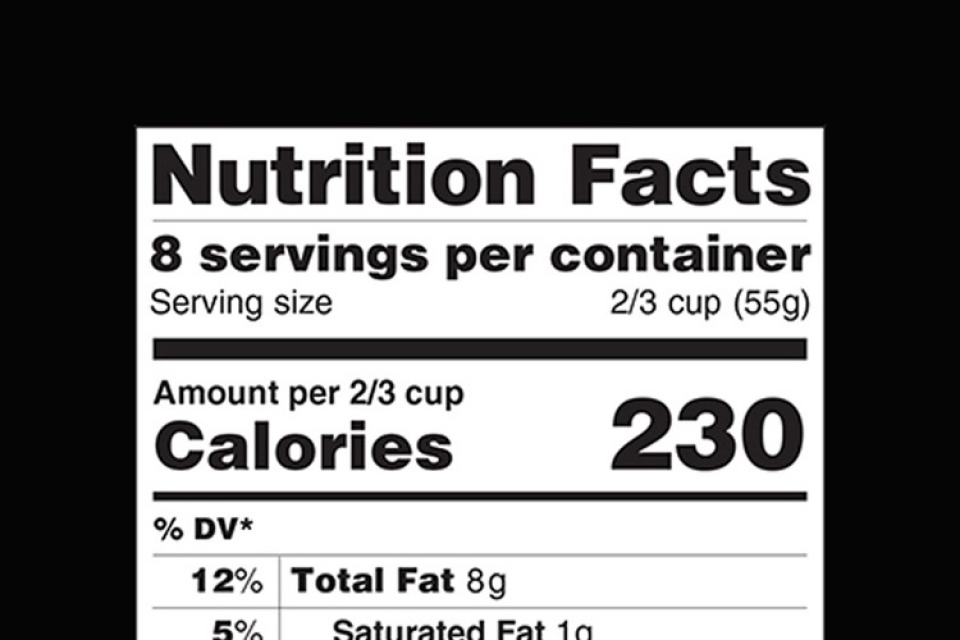A New Design for an Old Label
In case you missed it, the FDA released a new nutrition label design at the end of May. These changes will be rolled out on packages over the next two years and should be in place by July 2018. This is the first update to the nutrition label in the past 20 years!
At first glance, you may not notice that much has changed. The label will still be black and white, use the same font, and will still be laid out in a two column format. But the new design does take some steps to highlight important information so that it’s easier to find for consumers.
First, the FDA identified that making the serving sizes more realistic and that highlighting the number of calories in a serving was really important for making the labels more useful. To make these numbers stand out, they enlarged and bolded the serving sizes and calorie counts, along with passing new requirements to ensure serving sizes are based on how much a person would actually eat of the item in one sitting.
New label rendering by the FDA
A second big change was the addition of “added sugars.” The new labels will show how many grams of added sugar are in a serving and the percent daily value of those added sugars. The FDA, in their press release, stated, “It is difficult to meet nutrient needs while staying within calorie limits if you consume more than 10 percent of your total daily calories from added sugars…” Therefore, they wanted consumers to be aware of how many added sugars they were actually consuming per serving.
Another change focuses on nutrient daily values. The FDA removed required declarations of Vitamin A and C since deficiencies of these vitamins are rare in the US (companies can still include percent daily values of these vitamins if they choose to). The new labels will now show the percent daily values for iron, calcium, Vitamin D, and potassium. Additionally, the actual gram amount of each is required in addition to the percent daily value.
Lastly, the FDA updated the daily values of sodium, dietary fiber, and Vitamin D to be more consistent with the Institute of Medicine recommendations. Additionally, “Calories from Fat” will be removed from the label since the type of fat one is consuming is more important than the amount of fat one is consuming. “Total Fat,” “Saturated Fat,” and “Trans Fat” amounts will still be required on the label.
One more interesting note: dual column labels (see photo below from the FDA) will be used on packages for certain multi-serving products to show both “per serving” amounts and “per package” amounts. This will apply to products that could be consumed in either multiple servings or single servings, for example a pint of ice cream. The goal with the dual column labels is to help people more easily understand what they are consuming in one sitting.
The redesign took 3 years and involved the FDA, the public (through public commenting periods and focus groups), and food manufacturers and lobbyists. The reasoning behind adding more emphasis to serving sizes, calories, and added sugars was because of the FDA’s strong interest in addressing obesity rates in the US. By providing more accurate and easy to understand data, they hope to change people’s eating behaviors.
The FDA may be on to something. While some feel that nutrition labels have completely fallen out of favor, the Hartman Group reports that a majority of people say they actually do read nutrition labels. Their studies show that 81% of people who say they are watching their weight and 72% of people who are not watching their weight read nutrition labels. Their research also shows that many consumers “know what they are supposed to eat” and “what’s not so healthy.” The consumers they survey know that they should be eating more fruit or vegetables and that they shouldn’t eat as many processed snack foods. They also know what constitutes a “healthy” meal, but they don’t want to give up their indulgences. What is clear is that the new nutrition label is just one more tool for consumers to use to compare the many different food choices we have available to us. With the new updates, it will hopefully become a more useful, easily understood tool.
